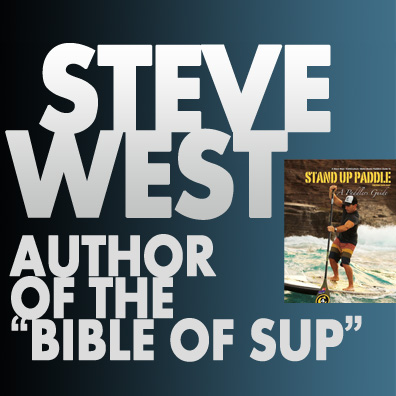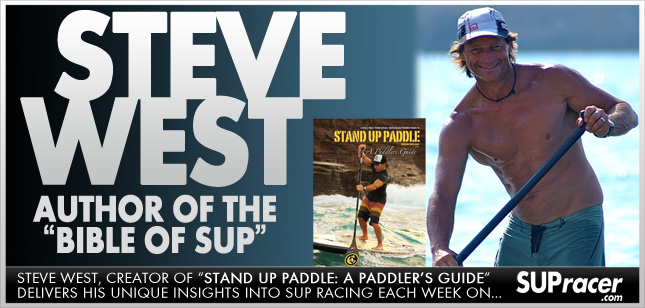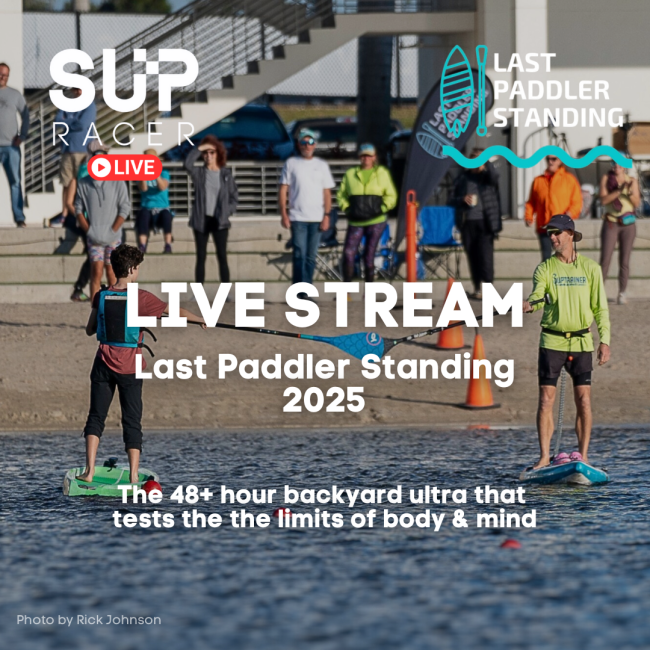
SUP Racing Needs A Paradigm Shift In Thinking (aka The Irrationality Of Restricting SUP Race Board Designs, Part II)

Boss Man’s note: Steve West is back with another important guest post/rant about the state of SUP race board designs. After last week’s article set off the debate, Steve continues it by suggesting what we need is a total shift in thinking at the fundamental level.
Interesting stuff as always, so check it out below. Also feel free to leave a comment at the bottom of this post when you’re done reading. Love to know if you agree or disagree…
MORE >>> Take a look at Steve’s previous articles about Stand Up Paddling and then consider purchasing a copy of his excellent book as well. If you’re a fan of SUP, I can guarantee you won’t be able to put it down…
*****
SUP Racing Needs A Paradigm Shift In Thinking (aka The Irrationality Of Restricting SUP Race Board Designs, Part II)
by Steve West
Catch up on The Irrationality of Restricting SUP Race Board Designs, Part I
Steve’s Note: . . . continuing on from the last post regarding stand up paddleboard length classifications, I think what is needed here, is a ‘Churchillian’ approach to the topic, that is to say the point needs to be reiterated to the point of absolute clarity so as the fundamental folly of what currently masquerades as ‘fair’ let alone necessary is understood. It’s clear it’s not.
A Paradigm Shift in Thinking
Rule 1. Stop thinking of SUP race boards as surf boards.
Rule 2. Stop thinking the underside of your board is the ‘underside’ or ‘bottom’
Rule 3. Start thinking of it as a ‘hull’ with infinite possibilities and complexities
Rule 4. Understand hull speed is related to waterline length, not length overall
“Hull speed is related to the waterline length of the hull. The concept was discovered by William Froude (1810-1870) when he observed the behavior of models of similar shaped hulls. Basically, he observed that the hydrodynamic resistance was dependent on the shape of the waves around the hull.”
If we’re to accept race board ‘divisions’ are based on ‘length overall’ how relevant to that concern should it be, that a 14′ board, may only have 9′ ‘length at the waterline’? Now you might want to think about that for a moment.
What this means is, there are boards classified as 14′ but which in fact, have shorter waterline lengths than some boards of 12’6″. Where is the logic in this and why has this singular fact escaped everyone’s attention?
This paradoxical fact, under-pins the very folly of imposing an overly-simplistic length over-all ruling, imposed on the basis of fairness in view of potential hull speeds and glide, which in actuality, is only determinable by using a formula concerned with the length of the hull in contact with the water, not that which isn’t.
Wherever race rulings are imposed regarding ‘length over all’ (LOA) of a paddled water craft (or indeed sailing craft) this is counter-poised with a ‘length at the water line’ (LWL). The current SUP ruling (one without the other) must be considered nothing less than naive and baseless as it only views hull design in the most rudimentary manner; how much of the board is in contact with the air, not the water. In short it is a ‘non-sense’ rule.
Consequently, it would in actuality be fair and reasonable to dispense of the current ruling entirely, rather than going down the path of introducing a length at the water line, avoiding an overly complex issue, which would give race officials a migraine of biblical proportions and would not be in the spirit of how our sport should evolve.
Ironically, all SUP boards are ostensibly ‘unlimited’ save for their overall length and as to whether they do or do no have a rudder system attached. In every other respect they are unlimited – to such an extent, that you could legally race a kayak, so long as you stood up doing so.
We can’t on the one hand agree that ‘it’s working’ and then suggest that 14′ makes a lot more sense for the purposes of ‘most’ race courses (and paddlers) because if that is so, then clearly ‘it’s not working’ and taken a step further, why wouldn’t 14’8″ ‘be best’ for a particular rider or 13’6″ or any other variant in-between, allowing that rider the opportunity to be competitive in competing against all-comers, in a race without boundaries – or divisions.
When you look at SUP boards for competitive or recreational SUP surfing, the choice is nothing short of epic – advancing inch-by-inch increments from the extremes of under 8′ to the realms of 12′ and then we hit 12’6″ – the brakes are applied in a cloud of rubber and dust through the appliance of a singular, misguided, length ruling, in the name of fairness and uniformity, a limit which is naive and unscientific in the context of determining one board’s advantage over another.
Why should a heavy paddler, disadvantaged on account of gravity, be nullified from racing ‘everyone’ on account of a requirement for more buoyancy through the use of a larger / longer board in order to be competitive, let alone the assurance of a more positive experience. Either way, they still have to paddle it and why should they be considered an exception to the rule, an outcast not in the running, considered too heavy to be in contention, pushed into a minority as a ‘part of the sum of the whole’ event, rather than being intrinsic to, an all inclusive mele of fun and the pioneering spirit, contributing to possibilities without limits?
Let’s not forget, 12’6″ boards exist, not on account of the fact they are blindingly fast, fit for purpose or hydro-dynamically optimum, nor even because we had the opportunity to explore the possibilities, but simply because 12’6″ blanks represent the upper end of what a shaper could lay their hands on and 14′ due to the existence of a prone paddle board division of this length.
Deliberately or unwittingly, the rule makers have created a level of discrimination, biased toward the lighter paddler and even go so far as to brandish a singular genre of board, ‘Elite’, so as others are relegated into the ‘also paddled’ group, but most significantly regardless of all other concerns, it’s the counter-evolutionary affect that this simple ruling has had upon what should be a sport in over-drive, without limits for the enjoyment and inclusiveness of all.




You must be logged in to post a comment.